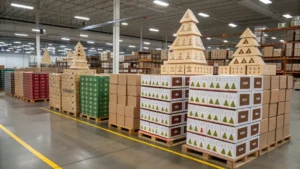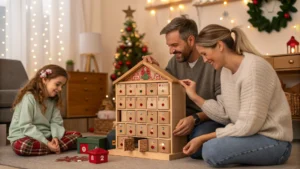
Tired of high costs for custom products? Retail prices eat your margins, making it hard to compete. sourcing directly from China manufacturers[^1] can slash costs and boost your product quality.
Sourcing a custom wood advent calendar from China involves finding a reliable manufacturer, providing detailed design specifications like CAD files[^2], and negotiating pricing. This direct approach significantly cuts costs by removing middlemen and leveraging economies of scale for a high-quality, reusable Christmas calendar.
When I first started my trading company, many clients came to me with amazing product ideas. But they were stuck. They couldn't find a way to produce them at a reasonable cost. They saw the high prices from local suppliers and thought their projects were impossible. I showed them that the principles I learned in the mold industry apply to almost any custom manufacturing. It's all about clear design, finding the right partner, and managing the process. Sourcing a custom wood advent calendar is no different. You just need a clear roadmap to follow, which is what I want to share with you today. Let's break down how you can make this happen for your business.
Sourcing directly from Chinese manufacturers can reduce product costs by up to 70% compared to domestic manufacturing.True
Eliminating layers of distributors, lower labor costs, and economies of scale in China's massive manufacturing ecosystem contribute to significant cost reductions for many product categories.
All wood products from China are made from bamboo.False
While bamboo is a popular and sustainable option, Chinese manufacturers work with a vast range of woods, including pine, birch, beech, and MDF, depending on the client's design, budget, and quality requirements.
Why is a Wooden Advent Calendar a Better Long-Term Investment?
Tired of flimsy, single-use advent calendars? They get thrown away each year, which is a total waste of money. A durable wooden calendar becomes a cherished family tradition.
A wooden advent calendar is a better long-term investment because of its durability. Unlike cardboard versions, it can be reused for many years, becoming a treasured holiday heirloom. This one-time purchase saves money and reduces waste over time.

When you design a product, you think about its lifecycle. It's the same way I think about a high-quality injection mold. You invest a lot upfront, but that mold can produce millions of perfect parts. A wooden advent calendar has a similar value proposition for the end consumer. It's not a disposable item. It's a one-time purchase that brings joy year after year. This is a powerful selling point. You are not just selling a calendar; you are selling a tradition. This perceived value allows for a higher price point and builds stronger brand loyalty. Let's look at how the materials and manufacturing process contribute to this long-term value.
Material and Build Quality
The choice of material is critical. It defines the product's feel, durability, and cost. While a simple cardboard calendar is cheap, it rarely survives one holiday season. Wood offers a premium and lasting alternative.
Manufacturing for Durability
The way a wooden calendar is made also adds to its value. Techniques like CNC routing[^3] ensure every piece is cut with precision. Laser engraving allows for detailed and permanent designs that won't fade or peel off.
| Feature | Wood (Pine, MDF) | Cardboard | Plastic |
|---|---|---|---|
| Durability | High (Reusable for years) | Low (Single-use) | Medium |
| Perceived Value | High (Heirloom quality) | Low (Disposable) | Medium |
| Customization | Excellent (Painting, engraving) | Good (Printing) | Good (Molding, colors) |
| Initial Cost | Higher | Lowest | Low to Medium |
| Long-Term Cost | Lower (One-time purchase) | Higher (Repurchased annually) | Lower |
Wooden toys and products can last for generations.True
Properly cared for, solid wood products are extremely durable and can easily be passed down, making them a sustainable and sentimental choice.
MDF (Medium-Density Fiberboard) is just as strong as solid wood.False
MDF is a cost-effective and stable engineered wood product, great for painting and CNC machining. However, solid wood is generally stronger, more durable, and more resistant to impact and moisture.
How Do You Ensure Quality When Sourcing in Bulk from China?
Are you worried about quality control with an overseas supplier? A bad batch of products could destroy your profits and your brand's reputation. The solution is a clear process for vetting, sampling, and inspection.
To ensure quality, you must vet manufacturers thoroughly. Always request and approve a pre-production sample[^4] before mass production begins. Provide a clear quality control checklist and consider hiring a third-party inspection service for the final check before shipment.
I can't stress this enough. In my years of making molds, a tiny error of 0.01mm can ruin an entire project. Quality is not something you check for at the end. It's something you build into the entire process. The same mindset is crucial when you're sourcing finished products. You are the designer, Jacky. Your vision is precise. You need to communicate that vision perfectly to the factory. Don't assume they know what you want. Provide detailed files, clear instructions, and objective standards for what is acceptable and what is not. This proactive approach saves you from costly surprises later. It turns manufacturing from a gamble into a predictable science.
Vetting Your Manufacturing Partner
Before you even talk about price, you need to know who you're working with. Ask for their business license, certifications (like ISO 9001), and examples of similar products they have made for other clients, especially those in North America or Europe.
The Critical Pre-Production Sample (PPS)
Never, ever skip the sample stage. The PPS is your golden sample. It is the physical proof that the factory understands your design and can meet your quality standards. You should test it, measure it, and try to break it. Approve it only when it's perfect.
Final Quality Control Checklist
Your checklist is the factory's guide to your standards. It should be simple and visual.
| Checkpoint | Standard | Tolerance |
|---|---|---|
| Wood Finish | Smooth, no splinters or rough spots. | Zero tolerance for splinters. |
| Paint Application | Even coat, no drips, correct Pantone color. | Color must match Pantone within 95%. |
| Drawer Fit | Drawers slide smoothly, no sticking. | Must open and close with minimal force. |
| Printed Numbers | Crisp, centered, and aligned. | Misalignment no more than 0.5mm. |
| Structural Integrity | No cracks, properly glued joints. | Product must withstand a 10lb pressure test. |
Third-party inspection services in China are very expensive.False
Basic pre-shipment inspections from reputable third-party services can cost as little as a few hundred dollars. This is a small price to pay to protect an entire shipment worth thousands.
A handshake deal is good enough for a sample order.True
While a formal contract is always best, for an initial sample order (which you pay for), the risk is low. The main goal is to test the factory's capability and communication, which the sample itself will prove.
What Are the Key Cost-Saving Factors When Ordering in Bulk?
Do unit costs on small orders seem too high? This makes your product uncompetitive in the market. Understanding the economics of bulk ordering[^5] can dramatically lower your per-unit price.
The main cost-saving factors are economies of scale[^6]. Ordering in bulk reduces the per-unit cost of raw materials, machine setup, and labor. It also makes shipping more efficient, which lowers the overall landed cost per item significantly.
This is a fundamental concept in manufacturing, whether you're making plastic parts or wooden calendars. Think about setting up a CNC machine or a production line. It takes the same amount of time and effort to set it up to make 100 units as it does to make 5,000 units. When you spread that setup cost over a larger number of items, the cost per item plummets. I've seen this with my clients over and over. They start with a small test order, and the price seems high. But once they prove the market and place a real production order, the numbers start to make sense. Let's look at where these savings come from.
Raw Material Costs
Suppliers give better prices for larger quantities of wood, paint, and hardware. A factory can pass these savings on to you when you place a large order.
Production and Labor Efficiency
As mentioned, the setup cost is a big factor. Also, workers become faster and more efficient as they repeat the same task. The labor cost per unit decreases as the production run gets longer.
Shipping and Logistics
Shipping a full container (FCL) is much cheaper per unit than shipping a small pallet (LCL). Maximizing your shipping volume is one of the easiest ways to reduce your landed cost.
| Cost Component | Order Size: 200 Units | Order Size: 2,000 Units | Explanation |
|---|---|---|---|
| Unit Price (Ex-Works) | $15.00 | $10.00 | Economies of scale in materials and labor. |
| Total Product Cost | $3,000 | $20,000 | Unit Price x Quantity. |
| Shipping Cost (LCL/FCL) | $800 | $4,000 | FCL is cheaper per cubic meter. |
| Landed Cost Per Unit | $19.00 | $12.00 | (Total Product Cost + Shipping) / Quantity. |
The price a factory first quotes you is always their best price.False
The first price is almost always a starting point for negotiation. Providing a target price and showing potential for future bulk orders can often lead to a better offer.
Air freight is a cost-effective way to ship bulk goods from China.False
Air freight is significantly more expensive than sea freight and is typically reserved for small, high-value items or urgent shipments. For a product like a wooden calendar, sea freight is the standard.
Conclusion
Sourcing custom wood advent calendars from China is a smart business move. It saves money and offers high-quality results. Follow these steps for a successful and profitable product line.
